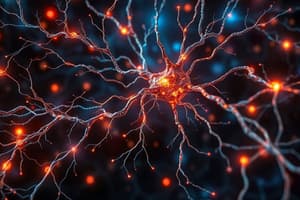Podcast
Questions and Answers
What are the principal divisions of the nervous system?
What are the principal divisions of the nervous system?
Central Nervous System (CNS) and Peripheral Nervous System (PNS)
What is the main function of the spinal cord?
What is the main function of the spinal cord?
To connect the brain and periphery and process information at involuntary and reflex levels.
Which part of the brain shows the largest increase through phylogeny?
Which part of the brain shows the largest increase through phylogeny?
- Cerebellum
- Thalamus
- Cerebral Cortex (correct)
- Hippocampus
What type of information do afferent nerves carry?
What type of information do afferent nerves carry?
Which of the following structures is known as the 'little brain'?
Which of the following structures is known as the 'little brain'?
The peripheral nervous system includes the brain and spinal cord.
The peripheral nervous system includes the brain and spinal cord.
The process by which one neuron is regulated by multiple inputs is known as _______.
The process by which one neuron is regulated by multiple inputs is known as _______.
Match the following parts of the nervous system to their meanings:
Match the following parts of the nervous system to their meanings:
What types of responses can be produced at synaptic terminals?
What types of responses can be produced at synaptic terminals?
Flashcards are hidden until you start studying
Study Notes
Nervous System Divisions
- Central Nervous System (CNS) consists of the brain and spinal cord.
- Peripheral Nervous System (PNS) includes nerves that connect to and from the CNS.
- Broad categories: Afferent (ascending) pathways carry sensory information to the brain; Efferent (descending) pathways transmit signals from the brain.
Brain Structure and Evolution
- The cerebral cortex shows the most significant increase in size through phylogeny, particularly in humans and higher mammals.
- Deep folding of the cerebral cortex increases surface area, essential for complex processing.
- The brain is central for integrative, cognitive, and higher-order processing.
Spinal Cord Functionality
- Acts as a "superhighway" linking the brain with the periphery.
- Processes information at involuntary and reflex levels.
PNS Components
- Afferent pathways: sensory (from external environment) and visceral (internal organ signals).
- Efferent pathways can be further classified into:
- Somatic (voluntary muscle control)
- Autonomic (involuntary control, subdivided into sympathetic, parasympathetic, and enteric systems).
CNS Structures and Nomenclature
- Names of CNS regions often reference shape, location, or individuals who discovered them:
- Hippocampus (Greek for "sea horse")
- Cerebellum ("little brain")
- Hypothalamus ("under the thalamus")
- Corpus callosum ("tough body")
- Thalamus ("inner chamber")
- Substantia nigra ("dark substance")
- Functional specializations correspond to structural distinctions.
Neuronal Connections and Network Organization
- Neurons demonstrate convergent and divergent patterns of connections:
- Convergent: One neuron regulates multiple targets.
- Divergent: One neuron is influenced by multiple inputs.
Synaptic Signaling
- Synaptic terminals facilitate communication between presynaptic and postsynaptic cells (neurons, muscles, glands).
- Large numbers of synapses provide excitatory or inhibitory input to dendrites, creating Excitatory PostSynaptic Potential (EPSP) or Inhibitory PostSynaptic Potential (IPSP).
- Responses hinge on neurotransmitters released and the specific ion channels that are activated.
Signaling Mechanisms
- Responses defined by the type of neurotransmitter and ion channel regulation, specifically through ligand-gated channels.
Studying That Suits You
Use AI to generate personalized quizzes and flashcards to suit your learning preferences.




